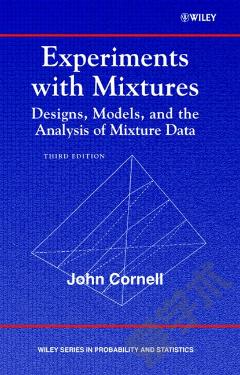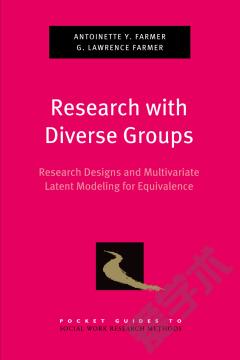Variations on Split Plot and Split Block Experiment Designs
Preface. Chapter 1. The standard split plot experiment design. 1.1. Introduction. 1.2. Statistical design. 1.3. Examples of split-plot-designed experiments. 1.4. Analysis of variance. 1.5. F-tests. 1.6. Standard errors for means and differences between means. 1.7. Numerical examples. 1.8. Multiple comparisons of means. 1.9. One replicate of a split plot experiment design and missing observations. 1.10. Nature of experimental variation. 1.11. Repeated measures experiments. 1.12. Precision of contrasts. 1.13. Problems. 1.14. References. Appendix 1.1. Example 1.1 code. Appendix 1.2. Example 1.2 code. Chapter 2. Standard split block experiment design. 2.1. Introduction. 2.2. Examples. 2.3. Analysis of variance. 2.4. F-tests. 2.5. Standard errors for contrasts of effects. 2.6. Numerical examples. 2.7. Multiple comparisons. 2.8. One replicate of a split block design. 2.9. Precision. 2.10. Comments. 2.11. Problems. 2.12. References. Appendix 2.1. Example 2.1 code. Appendix 2.2. Example 2.2 code. Appendix 2.3. Problems 2.1 and 2.2 data. Chapter 3. Variations of the split plot experiment design. 3.1. Introduction. 3.2. Split split plot experiment design. 3.3. Split split split plot experiment design. 3.4. Whole plots not in a factorial arrangement. 3.5. Split plot treatments in an incomplete block experiment design within each whole plot. 3.6. Split plot treatments in a row-column arrangement within each whole plot treatment and in different whole plot treatments. 3.7. Whole plots in a systematic arrangement. 3.8. Split plots in a systematic arrangement. 3.9. Characters or responses as split plot treatments. 3.10. Observational or experimental error? 3.11. Time as a discrete factor rather than as a continuous factor. 3.12. Inappropriate model? 3.13. Complete confounding of some effects and split plot experiment designs. 3.14. Comments. 3.15. Problems. 3.16. References. Appendix 3.1. Table 3.1 code and data. Chapter 4. Variations of the split block experiment design. 4.1. Introduction. 4.2. One set of treatments in a randomized complete block and the other in a Latin square experiment design. 4.3. Both sets of treatments in split block arrangements. 4.4. Split block split block or strip strip block experiment design. 4.5. One set of treatments in an incomplete block design and the second set in a randomized complete block design. 4.6. An experiment design split blocked across the entire experiment. 4.7. Confounding in a factorial treatment design and in a split block experiment design. 4.8. Split block experiment design with a control. 4.9. Comments. 4.10. Problems. 4.11. References. Appendix 4.1. Example 4.1 code. Chapter 5. Combinations of SPEDs and SBEDs. 5.1. Introduction. 5.2. Factors A and B in a split block experiment design and factor C in a split plot arrangement to factors A and B. 5.3. Factor A treatments are the whole plot treatments and factors B and C treatments are in a split block arrangement within each whole plot. 5.4. Factors A and B in a standard split plot experiment design and factor C in a split block arrangement over both factors A and B. 5.5. A complexly designed experiment. 5.6. Some rules to follow for finding an analysis for complexly designed experiments. 5.7. Comments. 5.8. Problems. 5.9. References. Appendix 5.1. Example 5.1 code. Appendix 5.2. Example 5.2 data set, code, and output. Chapter 6. World records for the largest analysis of variance table (259 lines) and for the most error terms (62) in one analysis of variance. 6.1. Introduction. 6.2. Description of the experiment. 6.3. Preliminary analyses for the experiment. 6.4. A combined analysis of variance partitioning of the degrees of freedom. 6.5. Some comments. 6.6. Problems. 6.7. References. Appendix 6.1. Figure 6.1 to Figure 6.6. Chapter 7. Augmented split plot experiment design. 7.1. Introduction. 7.2. Augmented genotypes as the whole plots. 7.3. Augmented genotypes as the split plots. 7.4. Augmented split split plot experiment design. 7.5. Discussion. 7.6. Problems. 7.7. References. Appendix 7.1. SAS code for ASPED, genotypes as whole plots, Example 7.1. Appendix 7.2. SAS code for ASPEDT, genotypes as split plots, Example 7.2. Appendix 7.3. SAS code for ASSPED, Example 7.3. Chapter 8. Augmented split block experiment design. 8.1. Introduction. 8.2. Augmented split block experiment designs. 8.3. Augmented split blocks for intercropping experiments. 8.4. Numerical example 8.1. 8.5. Comments. 8.6. Problems. 8.7. References. Appendix 8.1. Codes for numerical Example 8.1. Chapter 9. Missing observations in split plot and split block experiment designs. 9.1. Introduction. 9.2. Missing observations in a split plot experiment design. 9.3. Missing observations in a split block experiment design. 9.4. Comments. 9.5 Problems. 9.6. References. Appendix 9.1. SAS code for numerical example in Section 9.2. Appendix 9.2. SAS code for numerical example in Section 9.3. Chapter 10. Combining split plot or split block designed experiments over sites. 10.1. Introduction. 10.2. Combining split plot designed experiments over sites. 10.3. Combining split block designed experiments over sites. 10.4. Discussion. 10.5. Problems. 10.6. References. Appendix 10.1. Example 10.1. Appendix 10.2. Example 10.2. Chapter 11. Covariance analyses for split plot and split block experiment designs. 11.1. Introduction. 11.2. Covariance analysis for a standard split plot design. 11.3. Covariance analysis for a split block experiment design. 11.4. Covariance analysis for a split split plot experiment design. 11.5. Covariance analysis for variations of designs. 11.6. Discussion. 11.7. Problems. 11.8. References. Appendix 11.1. SAS code for Example 11.1. Appendix 11.2. SAS code for Example 11.2. Appendix 11.3. SAS code for Example 11.3. Index.
{{comment.content}}








 京公网安备 11010802027623号
京公网安备 11010802027623号